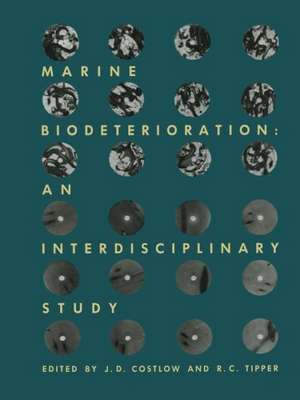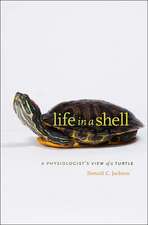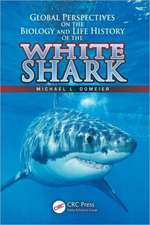Marine Biodeterioration: An Interdisciplinary Study: Proceedings of the Symposium on Marine Biodeterioration, Uniformed Services University of Health Sciences, 20–23 April 1981
Autor J.D. Costlawen Limba Engleză Paperback – 29 ian 2012
Preț: 409.51 lei
Nou
Puncte Express: 614
Preț estimativ în valută:
78.36€ • 82.25$ • 65.04£
78.36€ • 82.25$ • 65.04£
Carte tipărită la comandă
Livrare economică 11-25 aprilie
Preluare comenzi: 021 569.72.76
Specificații
ISBN-13: 9781461597223
ISBN-10: 1461597226
Pagini: 412
Ilustrații: XXIII, 384 p.
Dimensiuni: 210 x 279 x 22 mm
Greutate: 0.92 kg
Ediția:Softcover reprint of the original 1st ed. 1984
Editura: Springer Us
Colecția Springer
Locul publicării:New York, NY, United States
ISBN-10: 1461597226
Pagini: 412
Ilustrații: XXIII, 384 p.
Dimensiuni: 210 x 279 x 22 mm
Greutate: 0.92 kg
Ediția:Softcover reprint of the original 1st ed. 1984
Editura: Springer Us
Colecția Springer
Locul publicării:New York, NY, United States
Public țintă
ResearchDescriere
Biodeterioration held April 20-23, 1981, at the Uniformed Services University of the Health Sciences, Bethesda, Maryland. The symposium was sponsored by the Office of Naval Research to provide an organized forum for the discussion of progress in basic and applied research con cerning marine biodeterioration. The symposium was structured to cover interdisciplinary topics of interest both to the basic research community and the applied science and engineering communities. In each major topic area, a comprehensive overview paper summarizing highlights of the past two decades of research is followed by current technical papers concerning both basic and applied re search. Authors were urged to provide extensive refer ences, and their papers were subjected to external peer review. In some respects, the symposium was structured to pro vide a reference tool for the marine engineering com munity that would supplement the excellent monograph entitled "Marine Fouling and Its Prevention" prepared for the U.S. Navy Bureau of Ships in 1952 by the Woods Hole Oceanographic Institution. While these proceedings can not begin to update that work, they can, by presenting the in research direction, recent workers in the field, changes ac and current references, give the interdisciplinary user cess to the current literature in key topic areas.
Cuprins
Marine Wood-Boring Organisms.- An Overview of Research on Marine Borers: Past Progress and Future direction.- Abstract.- History of Marine Borer Research.- Recent and Current Research.- Future Direction and Needs.- The Microbial Ecology of Crustacean Wood Borers.- Materials and Methods.- Bacterial Isolation and Culture Media.- Results and Discussion.- Nutrition in the Teredinidae.- Abstract.- Larval Nutrition.- Adult Nutrition.- Filter Feeding.- The Role of Wood.- The Role of Dissolved Organic Material (DOM).- Symbiotic Bacteria.- Future Studies.- Biochemical Aspects of Molluscan Shell Mineralization.- The System of Shell Formation.- Ion Movement.- Control of Conditions for Shell Deposition.- Organic Constituents of Shell.- Energy of Shell Deposition.- Concluding Remarks.- Maintenance of Waterfront Structures.- New Structures.- Construction Techniques.- Existing Structures.- Inspection.- Restoration.- Repair.- Summary.- Recent Research and Future Trends for Protecting Wood in the Marine Waters.- Abstract.- Recent Research Efforts.- Microbiological Research Efforts.- Remedial Treatments.- Treated-Wood Strength Tests.- Future Trends in Research.- Microfouling.- The Microbial Ecology of Marine Surfaces.- Abstract.- The Primary Film.- Bacterial Repulsion from Surfaces.- Algal Fouling.- Control of Algae.- Invertebrate Settlement on Microbial Films.- Multi-Species Films.- Single-Species Films.- Lectin Model.- Inducer of Metamorphosis.- Implications for Other Fouling Organisms.- Control of Invertebrates.- Initial Events in Microbial Film Formation.- Abstract.- Methods and Materials.- Typical Results.- Discussion: Priorities for Future Research and Relationship to Ongoing Investigations.- Succession in Microfouling.- Methods and Materials.- Results.- Static Estuarine Experiment.- Flowing Marine Experiment.- Comparison Between Experiments.- Discussion.- Conclusion.- Determination of the Biomass, Physiological Status, Community Structure, and Extracellular Plaque of the Microfouling Film.- Abstract.- Methods.- Exposure of the Samples.- Analysis of the Samples.- Results and Discussion.- Scanning Electron Microscopic Morphology of the Microfouling Film.- Biochemical Analysis of the Microfouling Film.- Biomass.- Community Structure.- Physiological Status.- Extracellular Polysaccharide Formation.- Differences Between Microfouling Films on Titanium and Aluminum.- Effect of Brush Cleaning.- Morphology of the Extracellular Polymer Plaque.- Biochemical Analysis of the Extracellular Polymer Plaque.- Physiological Status Measurements.- Microbial Films and Energy Losses.- Abstract.- Measurement of Energy Losses due to Fouling Deposits.- Fouling Monitor.- Fouling Biofilm Formation.- Mathematical Model of Fouling Biofilm Formation.- Influence of Environmental Factors on Process Rate.- Other Factors Influencing Accumulation Rate.- Influence of Biofilms on Fluid Frictional Resistance.- Process Description.- Mathematical Model for Frictional Resistance due to Biofouling.- Other Factors Influencing Fluid Frictional Resistance.- Influence of Biofilms on Heat Transfer Resistance.- Process Description.- Mathematical Model for Heat Transfer Resistance due to Biofouling.- Other Factors Influencing Heat Transfer Resistance.- Summary.- Nomenclature.- Microfouling and Corrosion.- Abstract.- Microbiological Corrosion.- Corrosion Mechanisms.- Corrosion Effects on Microfouling.- Microfouling Effects on Corrosion.- The Influence of Microbial Fouling Films on Hydrodynamic Drag of Rotating Discs.- Abstract.- Experimental.- Rotating Discs.- Growth of Microbial Films.- Disc Torque.- Flat-Plate Drag Prediction Method.- Results.- Rotating Discs.- Similarity Law Predictions for Flat Plates.- Discussion.- Control of Microfouling in Ship Piping and Heat Exchanger Systems.- Importance of Microfouling Aboard Ship.- Fouling Control Methods.- Microfouling Control Experiments at Key West.- Equipment Description.- Microfouling Control Systems.- Method of Test.- Results.- Conclusions.- Fouling Larvae and Settlement.- Overview of Research on Marine Invertebrate Larvae, 1940–1980.- Fundamentals.- The Sequence of Development and Settlement.- The Pelagic Stage.- Provenance and Rearing.- Energy Requirements of Pelagic Larvae.- Swimming and Reactions to Light and Gravity.- Responses to Pressure and to Other Scalars.- Larval Navigation.- Sensory Structures in Pelagic Larvae.- Settlement.- Attachment and Exploration.- Larval Sense Organs.- Orientation.- Fixation.- Surface Films.- Texture, Contour, and Shape Preferences.- Territorial behavior.- Gregarious and Associative Settlement.- Settlement-Inducing Substances.- Metamorphosis Inducers.- The Future Course of Larval Biology.- Methods of Dispersal Among Fouling Organisms and Possible Consequences for Range Extension and Geographical Variation.- Dispersal of Larvae.- Larvae in the Open Sea.- Larvae in Coastal Waters.- Larvae in Estuaries.- Dispersal by Rafting.- Dispersal by the Activities of Man.- Geographic Variation.- Biochemical Control of Larval Recruitment and Marine Fouling.- Introduction: Biochemical Control of Larval Settlement, Attachment, and Metamorphosis.- Biochemical Inducers.- Facilitators.- Receptors.- Transducers.- Inhibitors.- Generality and Significance.- Conclusion.- Ascidian Larvae: Structure and Settlement.- Larvae of Solitary Ascidians.- Larvae of Colonial Ascidians.- Adhesive Papillae.- Noneversible Papillae.- Eversible Papillae.- Responses of Larvae to Light, Gravity, Specific Substrates, and Other Factors.- Metamorphosis.- Environmental Factors in Bryozoan Settlement.- Bugula as a Model System.- Surface Wettability and Settlement.- Adsorbed Organic Films and Settlement.- Microbial Primary Films and Settlement.- Competitive Ability and Gregarious Settlement.- Seasonal Changes and Fouling Community Interactions.- Seasonal Changes in the Fouling Community.- Fouling Community Development.- Competitive Interactions.- Seasonal Changes, Development, and Stability.- Macrofouling.- A Brief Overview of the Effects of Macrofouling.- Fouling on Ship and Submarine Hulls.- Seawater Piping Systems on Ships.- Sonar Domes.- Navigational Buoys.- Offshore Platforms; OTEC.- Coastal Power Stations.- Moored Oceanographie Instruments.- The Attachment of Microfouling Diatoms.- Field Experiments.- Laboratory Experiments.- Microscopy.- The Attachment of Fouling Macroalgae.- Spore Settlement.- Spore and Germling Attachment.- Initial Spore Attachment.- Release of Spore Adhesive.- Primary Rhizoid Formation.- Secondary Rhizoid Formation.- Histochemistry of Spore and Rhizoid Formation.- The Attachment of Macrofouling Invertebrates.- Site Selection.- Temporary and Permanent Attachment of Fouling Larvae.- The Attachment of the Mussel.- The Attachment of the Barnacle Larva.- Cementing Apparatus of the Adult Balanidae.- Chemistry of the Barnacle Adhesive.- The Structure and Stability of Marine Macrofouling Communities.- Theory.- Methods.- Results and Discussion.- Replicate Fouling Panels and Their Variability.- Abstract.- Panel Variability.- Species-Diversity Estimates Within a Series of Panels.- Percent-Cover Estimates Within a Series of Panels.- Surveys of Panel-Series Variability Within a Region.- Results.- Fouling Organisms.- Variability in Number of Sessile Species on Panel Series in Puget Sound at Nonpolluted Areas.- Variability in Number of Sessile Species on Panel Series in Puget Sound at Polluted Areas.- Variability in Percent Cover on Panel Series in Puget Sound at Nonpolluted Areas.- Variability in Percent Cover on Panel Series in Puget Sound at Polluted Areas.- Discussion.- Fouling and Paint Behavior on Naval Surface Ships after Multiple Underwater Cleaning Cycles.- Abstract.- Survey Plan.- Underwater Documentation.- Quantifying the Documentation.- Fouling Rating Scale.- Paint Deterioration Rating (PDR) Scale.- Ratings as a Diagnostic Tool.- The Fouling Rating Scale.- Paint Deterioration Rating Scale.- Using the Rating Scale.- When to Clean.- Paint Life.- Refouling.- Quality of Cleaning.- AF/AC Life Cycle Parameters.- Formulation.- Substrate/Primer Interaction.- Application of AF and AC.- Underwater Maintenance.- Underwater Repair.- Removal.- Disposal.- General Conclusions.- Coatings and Technology.- Coating Selection for Optimum Ship Performance.- Background.- Approach.- Renewable-Surface AF Coatings (Mechanical Rejuvenation).- Renewable-Surface AF Coatings (Self-Ablative).- Unattended Long-Term AF Coatings (Hard, Smooth, Low Leach Rate).- Unattended Long-Term AF Coatings (Controlled-Release).- Ship Preparation: Surface Preparation and Fairing.- Underwater Maintenance Techniques.- Cleaning and Macrofouling Removal.- Repairs, Touch-Ups, and Polishing.- Roughness Effects.- Surface Microroughness Measurements.- Factors for Coating Selection.- Screening and Field Tests.- Other Factors for Selection.- Economic Gains.- Conclusions.- Erosion and Hydrodynamics of Biofouling Coatings.- Abstract.- Theoretical Considerations.- Erosion and Seawater Flow.- Erosion and Coating Formulation.- Antifouling Performance.- Results with Slow-Eroding Formulations.- Conclusion.- Fluoropolymer Coatings for the Marine Environment.- Abstract.- Fluorinated Epoxies, Polyols, and Polyurethanes.- Sprayable Fluorinated Coatings.- Nonsprayable Fluorinated Coatings.- Field Operations.- Dynamic Coating Evaluation—Seamule.- Static Coatings Evaluation—Naos Island.- Surfaces Evaluated.- Frequency of Barnacle Settlement.- Barnacle Adhesion Measurements.- Barnacle Adhesion Data.- Future Research.- The Chemical and Physical Characterization of Marine Coatings Containing Organotin Antifoulants.- Coating Systems and Methods of Approach.- Toxicant Chemistry.- Leaching Mechanisms.- New Methods for in situ Coating Evaluations.- Conclusions.- Electrochemical Control of Fouling.- Abstract.- Electrolytic Hypochlorination.- Electrolytic Hypochlorination Evaluation.- Initial Test Results.- Test Program.- Test Setup.- Continuous Hypochlorination.- Intermittent Hypochlorination.- Biofouling Removal.- Conclusions.- Recommendations.- Toxicity Testing of Candidate Antifouling Agents and Accelerated Antifouling Paint Testing.- Antifouling Agents.- Toxicity Testing.- The Admiralty Marine Technology Establishment (AMTE) Sequence of Toxicity Testing.- Accelerated Testing of Antifouling Paints.- Removal of Leached Copper.- Fouling Control Technology.- Technology for Control of Marine Biofouling—A Review.- Abstract.- Sources of Marine Biological Fouling.- The Importance of the Slime Layer.- Interrelationships in the Marine Fouling Community.- Marine Biodeterioration.- Fouling Control Technology (FCT) Overview.- Designing Integrated Fouling Control Systems.- Problems with Working in the Ocean.- General Systems Overview—Cybernetics.- Definitions.- Basic Systems Approach.- Evaluation of Efficacy.- Bioactive Material Selection.- In Situ Tests.- Accelerated Tests.- Chemical Control Technology.- Toxic Control Agents.- Advanced Chemical-Control Concepts.- Scrubbing.- Historic and Economic Perspective.- Exterior Surfaces.- Interior Surfaces.- Sonics.- Electric Currents and Fields.- Magnetic Fields.- Optical Methods.- Nuclear Methods.- Thermal-Control Methods.- Osmotic-Control Methods.- Surface Modifications.- Explosive Removal Method.- Velocity-Control Techniques.- Appendix A: Performance of Selected U.S. Navy Antifouling (AF) Coatings.











